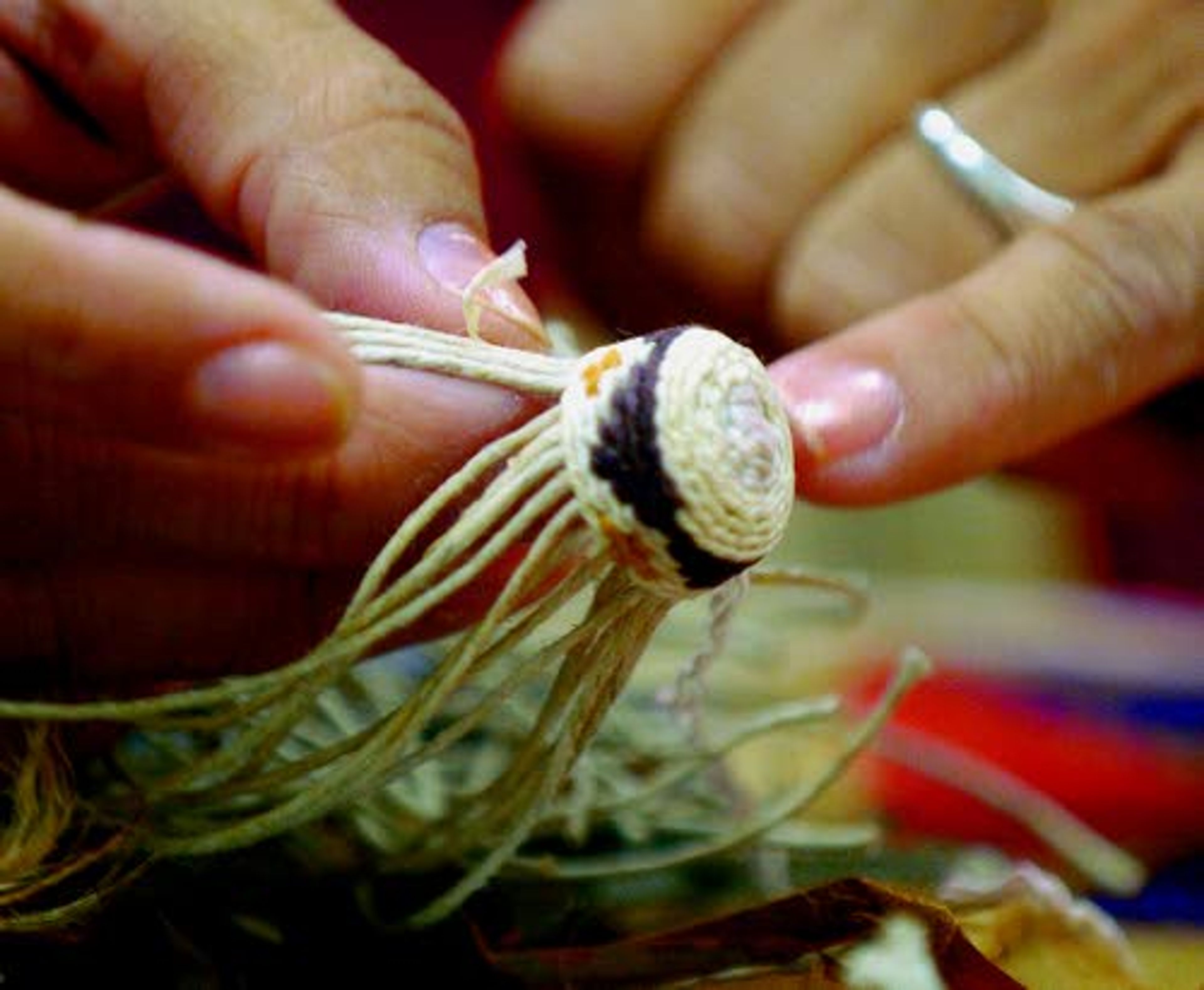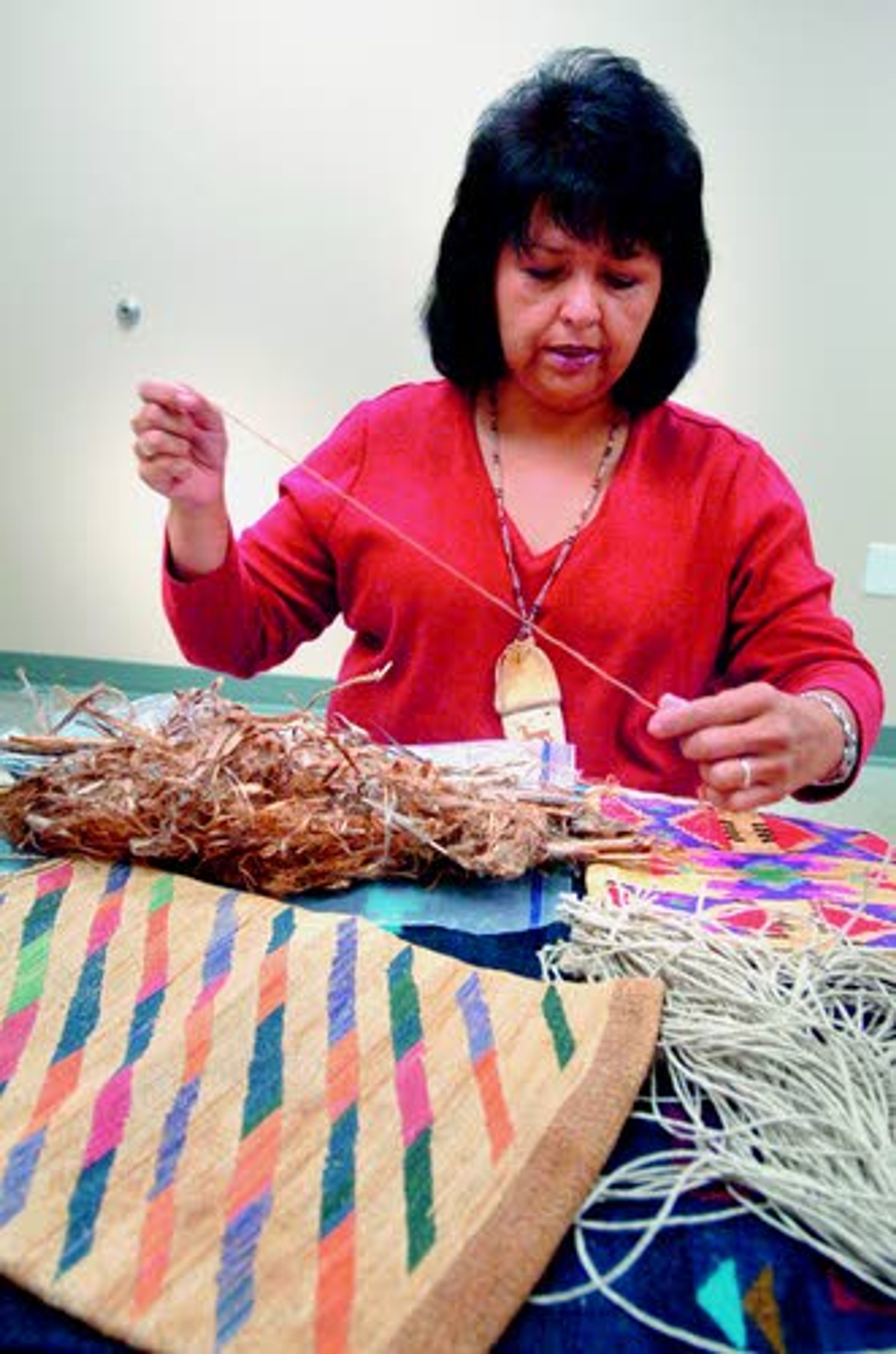LAPWAI - When people see corn husks drying on the dashboard of Jenny Williams' car the first thought to cross their minds probably isn't that these are supplies being prepared for an ancient art.
Williams is a Nez Perce weaver who uses the husks, along with dogbane, pine needles, tule and other natural fibers, in a complex and disappearing process to create bags, hats and baskets used traditionally by tribes around the country.
"It's a passion for me," says Williams, 56, who began weaving more than 15 years ago. Inspiration came from handling bags passed down through her family over the generations, including a foot-long flat twined handbag made from dogbane. The bag, with geometric designs in purple and orange on one side, was made to store food and other effects and is barely worn although it is more than 100 years old.
The desire to learn the secrets of weaving became stronger for Williams as she watched the generation of elders who knew the art pass away - people like Ida Blackeagle, Rose Frank, Hattie Hall, Katherine Ramsey and Mary Kane. On top of that, in the past few years she has noticed the disappearance of dogbane from local river banks. Also known as hemp dogbane, Indian hemp and American hemp, the herb has been declared a noxious weed by the U.S. government because of its toxicity to domestic livestock.
"They're trying to annihilate it and it's really sad," says Williams, who now travels to Washington each fall to harvest the plant. After the first frost, it is cut and the stems are split open to remove long, silky fibers that are then twisted into strings to provide cordage.
Dogbane was used by Indians because of its strength, durability and resistance to insects, she says.
From the twining to the mathematical process of weaving, the ancient art is time-consuming work. A strand-sized row in a bag can take an hour, says Williams, who has a child's corn husk hat in the Smithsonian's modern American Indian collection. A finished handbag representing hundreds of hours of work can sell for $1,500 or more depending on the amount of woven embellishment, which can include geometric symbols, animals, flowers, landscape features and petroglyphs. In the Nez Perce tradition she works a different design onto each side of a piece.
Williams is one of the weavers who will be at the Northwest Native American Basket Weavers Association's 13th annual gathering Oct. 5 to 7 at the Clearwater River Resort and Events Center outside Lewiston. The event, which takes place at a different location each year, is expected to draw more than 700 people and 35 master weavers. It is open to the public Oct. 6.
"The mission of the gathering is to bring weaving to every tribal community so it can be revitalized," says Ann McCormack, coordinator of the Nez Perce Leepwey Arts Council. "All tribes wove so that's a wonderful common ground we all have is that art form. There isn't an indigenous people that didn't weave."
There are many Nez Perce who weave, but McCormack says the difference today is that many of them make small objects like miniature bags on necklaces. In the past people made larger items like handbags. These things are now rare, as are corn husk hats, a traditional symbol of Nez Perce or Plateau Indian women.
Williams says the gathering is a tremendous opportunity for sharing knowledge between beginners, masters and the public.
"It's an amazing experience because art generates spirituality. You're working with natural materials and with a whole lot of people who are creating. ... The general public will be in awe of the different varieties of work, work they've never seen before."
Williams spends the summer months gathering natural materials with her husband, Dwight, and the two grandchildren she is raising. She uses modern dyes and Pendleton wool, along with natural dyes from Oregon grape vine, blood root and bark, to create color. She is home school liaison for the Indian Education program at Lapwai High School and through a grant teaches students traditional arts like weaving. Passing on the knowledge is one of the most important things to her.
"So few know the master techniques," she says. Many of the students are the first in their family to learn weaving in several generations. "It's there we need to broaden the area so we can go back to having many weavers."
One of the things she shows them is a tribal fish net made of dogbane that is more than 1,000 years old.
"I can appreciate the beauty of it because I know the work that goes into it," says Williams, who saves every stick of dogbane she collects.
---
Bauer may be contacted at jkbauer@lmtribune.com or (208) 743-9600, ext. 263.










